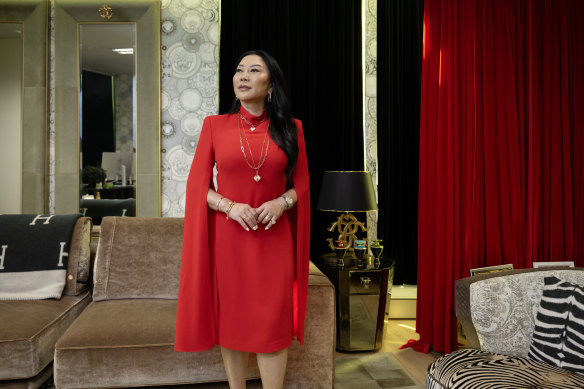[ad_1]
“Chinese may still buy expensive and nice properties, but they don’t necessarily want people to know about it,” said Qiang Li, associate professor at Deakin Business School in Melbourne, who focuses on real estate. “That becomes harder when you make a high-profile purchase like this.”
Loading
The shift in Chinese buying patterns has reverberated through luxury developments in cities including Hong Kong and London. In Australia, it coincided with a dramatic worsening of ties with its Asian neighbour.
Chinese investments collapsed over the past five years after Canberra stepped up scrutiny of foreign acquisitions, cracked down on foreign interference and called for a probe into the origins of COVID-19. In 2023, direct investment by Chinese companies was the second lowest in 18 years, according to a report from KPMG and the University of Sydney.
While relations have warmed in recent months, this is unlikely to spur fresh interest from China’s wealthy, who are restricted from parking their cash overseas.
“We’re still dealing with Chinese-origin buyers, but they already have residency here,” Tu said. “They are not necessarily holding a Chinese passport anymore.”
Investment by Chinese entities in Australia’s commercial and residential real estate sector totalled almost $13 billion last year, down 60 per cent from the frenzied buying seen in 2016, according to Foreign Investment Review Board figures. By law, overseas buyers of Australian homes are limited to new builds.

Monika Tu, pictured in her Sydney office.Credit: Louie Douvis
Crown, now owned by US private equity giant Blackstone, had its own run-in with Xi. In late 2016, a crackdown by Chinese authorities led to the conviction of more than a dozen Crown employees for illegal promotion of gambling and sparked a global retreat by the company.
Then, in 2019, reports by this masthead that criminal gangs laundered cash inside Crown’s casinos triggered a string of inquiries in Sydney, Melbourne and Perth. The probes uncovered a range of shortcomings and found Crown was unsuitable to run casinos in the three cities. Packer departed not long after.
The regulatory outlook for Crown is improving. Last month, the company was allowed to keep its license to operate its casino in Sydney. That came weeks after the company retained the licence to run its casino in Melbourne, where the state regulator said Crown had rectified misdeeds, including underpaying taxes and facilitating money laundering.
Loading
Yet, the disappearance of Chinese high rollers continues to be felt.
Last year, the company closed one of its two VIP gambling floors at One Barangaroo in Sydney and laid off 275 people. It will cut a further 1000 jobs across its three Australian gaming resorts. The delisted company, which was acquired by Blackstone in 2022 in an $8.8 billion takeover, posted a $199 million loss last year.
All the more reason for Crown to expedite the sale of the Sydney penthouse.
Tu is confident she will find a buyer. She travelled to Los Angeles this week to market the home and is working through her Rolodex of the wealthy. She has cachet. Tu sold two of the top 10 properties in Australia last year, including a $60 million five-bedroom house in Point Piper.
The 62-year-old selling agent, who moved to Australia in 1988 from Shenzhen in southern China, said she has received initial interest from people in Australia and countries in South-East Asia, including Cambodia, Vietnam and Singapore.
“There is nothing like this in terms of quality, views and location,” she said during a tour of the apartment.
The property’s extravagant features, prominence in Sydney’s tallest building and central location are among its selling points.
There’s a terrace, a gym, a wine cellar, internal elevators and a private garage that can fit four vehicles. Residents have access to 24-hour concierge and VIP treatment at the hotel’s 14 bars and restaurants, including Nobu and Oncore by Clare Smyth. Such amenities come at a cost of $65,000 per quarter in management fees.
Loading
The tower, designed by the late British architect Chris Wilkinson, won the global Emporis Skyscraper Award in 2020 in a first by an Australian structure.
Big-ticket sales have happened in the area before. A larger penthouse in a neighbouring building sold in 2019 for $140 million, an Australian record by total value.
Both are part of the redevelopment of Barangaroo, which was an industrial hub before becoming part of one of the city’s largest and most controversial urban renewal projects. The suburb now contains residential and office blocks, a ferry pier and parks.
One Barangaroo’s roots in a vanished gilded age means a property like this is unlikely to be constructed anytime soon. And that, for Tu, is part of its appeal.
“I understand what rich people want, and so I’m telling them: buy it now, or you’ll never get one like this,” said Tu, standing on the terrace as she watched the light fade over the city.
“If you want a piece of the best thing in Australia, then this is it.”
Bloomberg
The Business Briefing newsletter delivers major stories, exclusive coverage and expert opinion. Sign up to get it every weekday morning.
[ad_2]
Source link


